Aviation history: capturing schooner by plane
One can only wonder how this man, with his dubious - from the point of view of the Soviet power - origin and past, managed to survive three wars in the fire and avoid repressions that almost wiped out the people of his circle, and not sacrifice the honor and dignity of the cadre officer.
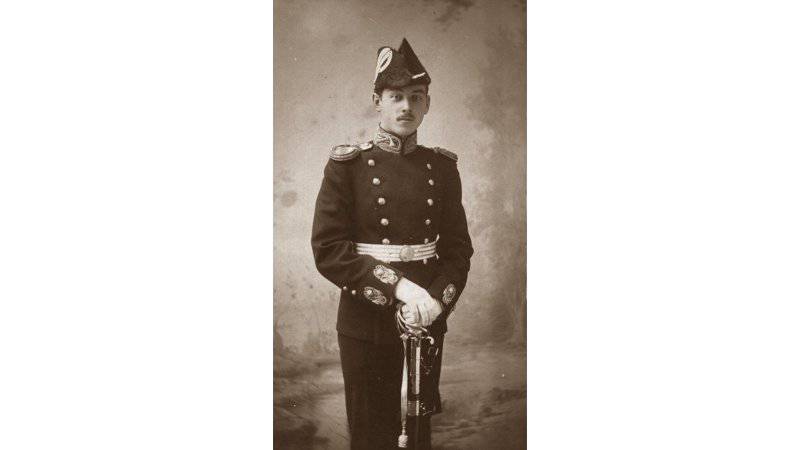
The arrival in the aviation of the fleet lieutenant Sergeev can be considered to be somewhat random. A graduate of the Sea Corps 1913 of the year, who graduated thirteenth in the list, chose the Black Sea Fleet for further service. One can imagine the ambitious dreams of a young capable officer related to the upcoming appointment, and the depth of the disappointment that befell him. Instead of a warship, he turned out to be the commander of a battery launched by the battleship Sinop, hopelessly outdated by the beginning of World War I, launched in 1889, which was intended to play the role of a branded ship guarding the entrance to Sevastopol Bay. It is possible that midshipman Sergeev was obliged to such a despondent start of his career. Since the time of Tsar Alexei Mikhailovich, when the ancestor of the Sergeev family, Father Michael, was obedient to the Trinity-Sergius Lavra, several generations of his descendants were priests. So the father of our hero was a simple rural father, the abbot of the church in the village of Sretensky of the Vyatka province.
And in the Black Sea Fleet, as a rule, entire marine dynasties were connected with each other by perennial kinship and friendship ties. These include, in particular, the commander of Sinop - Baron Peter Ivanovich Patton-Fanton-de-Verrion, from the Russified Belgians, honored sailor, participant of the Russian-Japanese war, who became the rear admiral of the Russian fleet in 1915 year.
Past "Sinop" passed, going to sea and returning from hikes, ships, which served as friends of midshipman Sergeev. Some had time to distinguish themselves in battles, to advance in service, to deserve insignia, and on the fire brigade days filled with routine tasks and duties of an artillery officer.
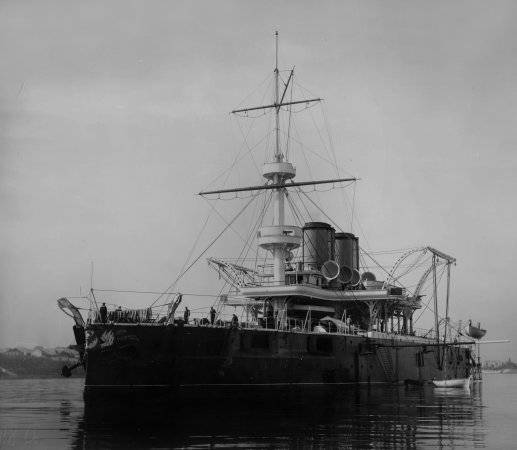
Since the beginning of the war, the formation of aviation units of the fleet proceeded in an accelerated manner. As part of the Black Sea squadron, two hydrocrusters appeared: "Emperor Nicholas I" and "Alexander I"; and later one more - "Romania". They could carry 6 – 8 aircraft. In the course of the hostilities, it became clear that airmen were capable of taking on many important tasks in the interests of the fleet.
The first experience of using naval aviation took place on 24 in March on 1915, when the Black Sea squadron, which included the “Nikolai I” hydro-cruiser, made a march to the shores of Rumelia. Airplanes that had risen from the deck of an air-launch vehicle bombed enemy positions. And on May 3, Russian seaplanes raided the capital of the Ottoman Empire, Istanbul.
Just a few years ago, in the fall of 1910, Mikhail Sergeyev, a graduate of the Marine Corps, had a chance to attend the All-Russian aeronautical festival held at the Commandant airfield, near the Black River. That day pilots Ulyanin, Rudnev and Gorshkov showed skill on biplanes and Farmans, and also Matsievich, Ermakov and Utochkin on Blerios. And here, on the Black Sea Fleet, Sergeyev first flew, as a passenger, on an educational double monoplane of the Moran-F type, manned by the commander of the Belbek station aviation squad, captain Karachayev.
Mikhail Mikhailovich made the decision to become a sea pilot and filed a report to the command asking him to send him to study. The request of the young officer was satisfied, and at the beginning of 1916, Warrant Officer Sergeev was enrolled in a school of naval pilots located on Gutuev Island in Petrograd, where they were taught to fly M-2 seaplanes. After its graduation in December 1916, Mikhail Mikhailovich, who had become a lieutenant by this time, returned to the Black Sea Fleet as a sea pilot.
By the beginning of 1917, the Black Sea Fleet naval aviation forces had grown to 110 aircraft. An air division of the Black Sea was formed: the 1 brigade consisted of four ship detachments (then six), the 2 brigade included land-based 13 detachments. It is noteworthy that almost all seaplanes were domestic production, the design of D.P. Grigorovich: M-5 (reconnaissance, artillery fire spotter), M-9 (heavy seaplane for bombing land objects and ships), M-11 (the world's first seaplane fighter).
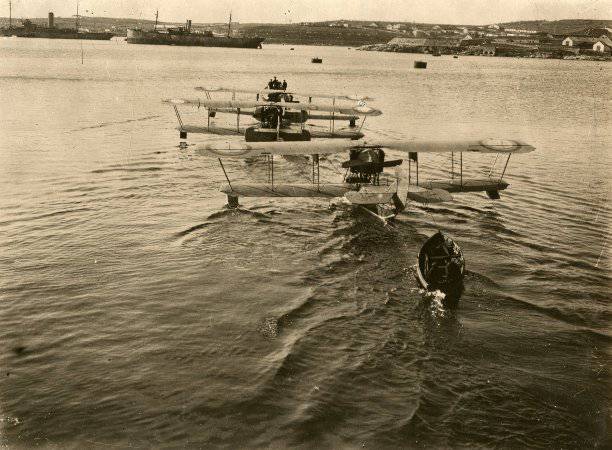
In the order for the fleet on 1917, the year before the air division was set a wide range of tasks, testifying to the recognition of the role and importance of naval aviation:
1) attack of enemy ships, its bases and coastal fortifications;
2) fighting with the enemy air forces;
3) anti-submarine warfare;
4) surveillance and aerial reconnaissance;
5) the protection of the fleet at sea from enemy aircraft and its submarines;
6) adjustment of ships artillery fire.
The main objectives of the naval pilots during this period were military installations in Varna and Constanta, as well as coastal fortifications in the Bosphorus region.
12 (25) March 1917, the 8-nd Black Sea Fleet hydro squad, in which Lieutenant Sergeyev served, was ordered to dive aboard ships and go to the Bosphorus area. Along with the tasks of reconnaissance and aerial surveys of the coastal strip, the pilots were to destroy the enemy’s artillery batteries at Cape Kara-Burun with bombs.
It was one of the most fantastic flights in the history of naval aviation. Here is how these events are described in the “Military Chronicle of the Russian Fleet”: “A seaplane of the Black Sea Fleet aviation under the command of pilot Lieutenant Mikhail Sergeyev and under the supervision of non-commissioned officer Felix Tour, received during a shelling of aerial reconnaissance over the Bosphorus a bullet hole in a gasoline tank from which gasoline, was forced to plan on the water in the area of Derkos (Rumelian coast) out of sight of the accompanying Russian ships. After picking up the returned planes and finding Lieutenant Sergeev's plane shot down or captured, the ships left in Sevastopol.
Meanwhile, Sergeev and Tur, seeing a Turkish schooner not far from themselves, using the remnants of gasoline, attacked her and, having opened fire with a machine gun, forced the Turks to leave the schooner hastily and flee to the shore on a boat. Capturing the schooner, the pilots destroyed the plane, after removing from it all the valuable parts, the machine gun and the compass, and, raising sails, went to Sevastopol.
After a six-day voyage, having withstood the storm, without provisions and almost without water, the pilots arrived at the Dzharylgach spit, where, having made themselves felt through the SNiS post, were taken to the destroyer sent for them. "
Mikhail Mikhailovich was convinced that the training in the Marine Corps, which was then headed by an excellent sailor and artilleryman, Voin Petrovich Rimsky-Korsakov, who had instilled a love for the sea and sailing to young people, helped him withstand the strongest storm and arrived safely at the Crimean coast.
The distinguished pilot was summoned to the commander of the Black Sea Fleet A.V. Kolchak. Impressions of this meeting M.M. Sergeyev shared in his memoirs: “The next day I was summoned to Kolchak to the headquarters of the Black Sea Fleet on the battleship Georgiy Pobedonosets. and strong-willed features. He congratulated me on seizing the prize and listened attentively to a story about the capture of the schooner by plane - the first in aviation history. A week later I was handed the St. George weapon".
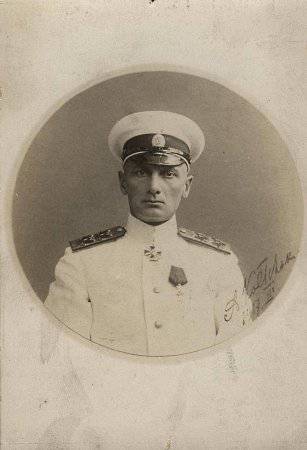
It should be noted that before this young officer managed to earn two orders: St. Stanislav III degree with swords and bow and St. Anna IV degree.
5 (18) May 1917 of the year, during the next flight in the area of Constanta, Mikhail Sergeev, returning from a mission, was attacked by three German hydroplanes, one of whom shot down, but he could not avoid the machine-gun bursts, was wounded and captured.
So the first time death almost touched him with his wing.
He returned to his homeland after the war, in December 1918, unconditionally took the side of Soviet power. It is hard to imagine what could have happened to him if it had not been for captivity. It is possible that Lieutenant Sergeev would share the fate of many officers of the Black Sea Fleet. According to modern historians, the victims of the "revolutionary sailors" in 1917 – 1918 were about 600 officers of the Russian army.
Despite the fact that the former lieutenant of the Russian Imperial Navy voluntarily entered the Red Army, he most likely did not enjoy the confidence. Otherwise, it is difficult to explain the fact of his prolonged stay first in the reserve of aviation specialists of the Moscow Regional Directorate of the Air Force of the Red Army, and then in the position of junior mechanic of an air force-workshop of the Air Force of the Eastern Front. However, the majority of the pilots of the Red Army were former officers, many of them were mobilized by force, so the transfer of the red military to the side of the whites at that time was a frequent occurrence. All the more surprising, in May 1919 of the year, the recent clerk for the technical staff of the Eastern Front Air Force suddenly became Chief of the Air Fleet of the 3 Army on the same front, where he was to support the actions of the Red Army soldiers against the forces of the former Black Sea Fleet commander Admiral A.V. Kolchak, who has now become the supreme ruler and supreme commander of Russia.
It is difficult to judge what forces the head of the 3 Army’s fleet had. It is known, for example, that during the summer battles on White, in the summer of 1919 of the year, there were about 15 machines at the disposal of the Reds. At the same time, because of the lack of air bombs, such "formidable weapons" as rails and cobblestones were often used. In addition, most of the losses of the aircrew on both sides were related to the technical condition of the aircraft: the airplane could literally collapse in the air, not to mention the failure of the engine and controls.
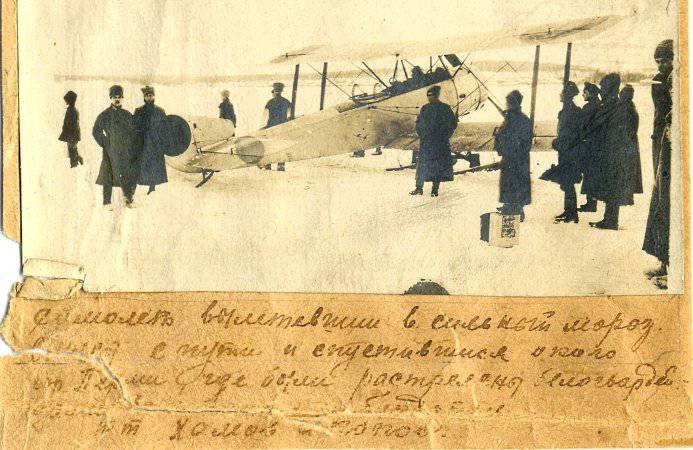
Later, until the end of the Civil War, MM Sergeev, without ceasing to fly, held senior command positions in the air armies of the South-Western and Southern fronts.
Shortly before the start of operations to liberate Crimea from Wrangel’s troops - the Armed Forces of Southern Russia, Sergeyev, as deputy chief of the Air Fleet of the Southern Front, had the opportunity to work under Mikhail Vasilyevich Frunze, from whom he received operational tasks and to whom he reported on the preparation of operations.
Preserved story M.M. Sergeev about this period of his service: "During the first meeting, Frunze demanded a report on the state of the air forces, listened very carefully, demanded an immediate reconnaissance of Aleksandrovsk (now Zaporozhye) districts, south of the Crimean isthmus in order to ascertain the line of attack of the enemy. The reconnaissance detachment consisting from the Farmans and the Vozens, with a range of more than 400 km, completed the task. On the way back, almost at the front line, I had to organize the refueling of the aircraft with fuel.
Frunze personally supervised the preparations for the operation against Wrangel. His office hours were night and day, from 0 to 4 and from 12 to 16 hours. On the night reports, he usually gave instructions the next day, on the basis of which a detailed action plan was drawn up. The air forces of each army were assigned a specific task. 10 or 11 hours in the morning to the headquarters came reports on the implementation of intelligence. The chief of staff systematized, processed the reports: intelligence data, bombing results, information about air battles. Aerial reconnaissance reports were received by the operational section of the front headquarters, where they were compared with data from other types of intelligence, to clarify the position of the enemy’s positions. Then the commander received reports on the implementation of the tasks he received. "
But the tasks of controlling the air force were now of a completely different character. By September, the 1920 of the year in the squadrons of the Southern Front numbered about 80 aircraft (of which about 50% were in good condition), including several Ilya Muromets heavy bombers. Such an aircraft raised bombs to 16 pounds (256 kg) and could cause very serious damage to the enemy. On September 2, one of the Muromtsevs under the command of the Shkudov krasvoenlet dropped 11 pounds of bombs to Prishib station, where the headquarters of the Drozdovsky officer division was located. Six people were injured at the station, including artillery general Polzikov. Another successful operation was the bombing of the German colony of Friedrichsfeld, where about three thousand White Guards gathered.
After the civil war, MM Sergeyev became the first "commander" - the head of the Air Fleet of the Black and Azov Seas, simultaneously performing the duties of the head of the naval aviation school in Sevastopol. These skills were useful to him when, after a short service, he became a teacher of the Higher Air Force Academy in 1927. NOT. Zhukovsky.
Being an experienced aviator and commander, Mikhail Mikhailovich never stopped learning. He graduated from the school of aerobatics in the Sevastopol region Kacha and refresher courses of the highest command personnel at the Naval Academy. K.E. Voroshilov.
By the time of departure M.M. Sergeev, in the long-term leave, as recorded in his pension book, in the buttonholes of the veteran’s uniform who had served in the 20 armed forces for years, had two diamonds, which corresponded to the first “general’s” rank of division commander. The commander-in-chief of the Air Force, Alksnis, had three such lozenges at that time, and the future “red marshal,” K.E. Voroshilov - four.
The departure from the army testified to the vision of Mikhail Mikhailovich, who understood that the former lieutenant of the Imperial fleet, descended from the “clerical environment” of the clergy among the proletariat, would be the first victim of any purge of the Red Army. Therefore, it was better for him to stay in the shade, and even better - away from both capitals. It is easy to imagine what fate awaited Sergeev in 1937 – 1938, he remain in the frames of the Red Army ...
M.M. Sergeev moved to the Far North, where, at the suggestion of Otto Yulievich Schmidt, he became deputy chief for the marine part of the West-Taimyr expedition of the Polar Aviation Administration of Glavmorsevput. Along with hydrographic surveys, the expedition had to find places suitable for the creation of polar aviation airfields. Here the experience of Mikhail Mikhailovich as a sailor and as an aviator was equally in demand.
During the 1933 expedition of the year, the schooner "Belukha" under the command of M.M. Sergeeva conducted a reconnaissance marine and topographical survey of the island of Bukharin, on which two navigation signs were installed. The second largest island of the archipelago received two names at once, as it was taken for two sections of land. One was named the island of Sergeyev, the captain of Belukha, and the other the island of Gronsky (a famous Soviet public figure and writer). The Belukha Strait, Gavrilin Island (in honor of the senior mate of the captain), Cape Everling (after the expedition member oceanologist AV Everling, a graduate of the 1910 Marine Corps of the year) also appeared on the maps. The expedition was off the coast of the archipelago until September 3, after which it headed for the island of Solitude. Belukha reached the Fram Strait, the archipelago of the Izvestia CEC Islands, carried out a number of important scientific works. A documentary film was made about the expedition of the West Taimyr expedition. But in the Kara Sea on the transition to Arkhangelsk "Belukha" got holes and sank. The crew was rescued by the ship Arkos.
Life Sergeeva again was in the balance: the death of the vessel could easily be regarded as a fact of sabotage. There were enough precedents, and it was not taken into account that the knowledge of the Arctic Ocean left much to be desired, and the Arctic storms and ice are capable of making adjustments to any plans. Only in the 1933 navigation, the tugboat Ruslan, returning from Franz Josef's land, and the Revolutionary steamer, which made the transition from Lena to Kolyma, were killed. But this time everything was fine.
After the adventures in the Arctic, in 1935, Mikhail Mikhailovich Sergeev joined the group of talented and assertive inventor Leonid Vasilievich Kurchevsky. One of the areas of work of this team was the development of dynamo-jet guns (DRP), a prototype of recoilless guns.
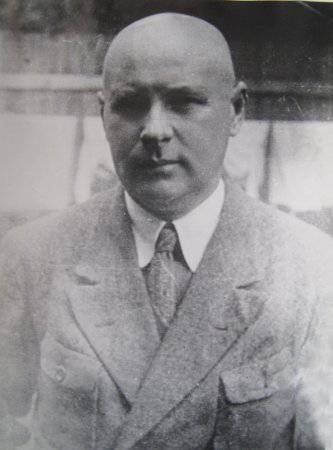
Kurchevsky, who enjoyed the location of Marshal M.N. Tukhachevsky, were given almost dictatorial powers and unlimited funds. For it, the Special Design Bureau No. 1 of the Red Army Directorate is created, the plant No. 38 in Podlipki, near Moscow, is handed over to him at which Sergeyev, an aviation armament engineer, worked from 1936 until the beginning of World War II.
Mikhail Mikhailovich was actively involved in the work related to the testing of DRP. The sight was set up in Pereslavl Zalessky, on Pleshcheyevo Lake. Shooting from airplanes was carried out on the target, which used the shadow of the airship "B-1" on the surface of the lake. Subsequently, the fighters "I-4" installed guns caliber 67 mm, and on the "I-12" - 102 mm.
Marshal believed in Kurchevsky’s guns so much that he decided to re-equip all the artillery of the Red Army, Air Force and Navy with them! At the same time, serious design flaws and limited use of these weapons in combat were not taken into account. Adventurism Tukhachevsky and Kurchevsky cost the country dear. An enterprising inventor was arrested and accused of creating unpromising armaments from 1933 on the instructions of Tukhachevsky. Almost at the same time with the designer, Tukhachevsky and almost the entire leadership of the Red Army Directorate led by commander Yefimov were arrested.
As often happened with us, the development of advanced weapons was stopped after that, despite the possibilities of their effective use. In the late 1930-x samples of the PDD were removed from service. But soon the recoilless armor-piercing guns appeared in Germany and among our allies, were successfully used on the fronts of the Second World War. Later, the production of DRP resumed in the USSR. Modern Russian RPGs, based on the same principle as DRP, now penetrate armor with a thickness of more than 500 mm.
The wave of repression did not bypass even simple engineers, but this time Sergeyev was not injured. Fate still kept the former lieutenant of the Imperial fleet.
With the beginning of the Great Patriotic War, the retired "division commander" filed a report addressed to the People's Commissar of the USSR Navy about returning to service. The request was granted, but instead of the honored title of senior officer, the attestation commission awarded him the rank of lieutenant.
It's good that, taking into account the knowledge and experience of an artillery specialist, 50-year-old Mikhail Mikhailovich was not sent to the front with a rifle, but was appointed inspector of artillery of the Volga military flotilla in Stalingrad. There, he was destined to meet with his son, Konstantin, who received the same title after graduating from the Higher Naval Engineering School named after F.E. Dzerzhinsky. In the same place, next to them, Mikhail Mikhaylovich’s wife, Natalya Nikolaevna, worked as a nurse in the front-line hospital.
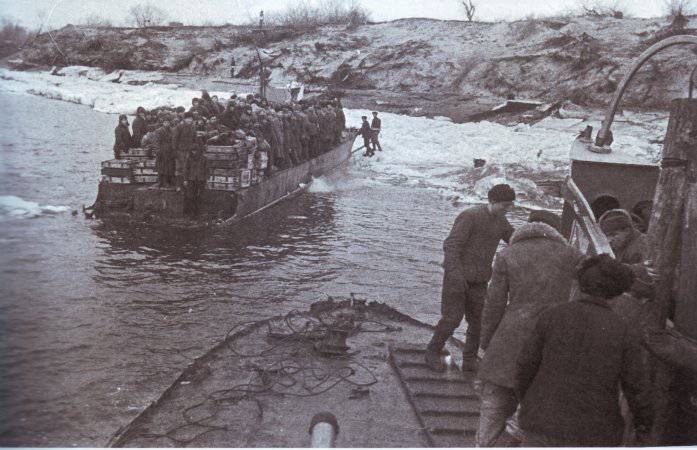
The composition of the Volga military flotilla looked variegated: in addition to minesweepers armed with 7,62 mm machine guns and trawls, it included monitors converted from tugboats, barges that delivered gas, oil and fuel oil to the besieged city. They installed artillery mounts with a caliber of 100, 120, and even 150 mm. Plywood river buses were used as vehicles. The most formidable warships were considered armored boats. Their weapons were extremely diverse: there were tank turrets, and Lender anti-aircraft guns, and large-caliber DShKs, not counting rifle-caliber machine guns. Some even installed the legendary Katyusha multiple launch rocket launchers - M8 and M13. All missile and artillery weapons of the flotilla were under the command of Lieutenant Sergeyev, who knew his job well. The gunners sincerely respected the inspector and cherished like the apple of an eye.
Flotilla ships trawled, escorted and transported troops to Stalingrad, firing enemy positions. Sometimes they made flights through the Volga the night before 12, and everyone could be the last. But on the left bank was not safe. German aircraft reigned in the sky, from which it was impossible to hide in dugouts and crevices dug in the steppe. Especially memorable was the 23 raid of August 1942, when Stalingrad was still living as a frontline rear town, not ready to repel massive air raids.
Enemy aviation in a matter of hours turned the city into ruins, killing more than 40 thousands of people. It was not only buildings that were burning, the land and the Volga were burning, because the oil tanks were destroyed. On the streets of the fires there was such a heat that clothing flared up on people fleeing to shelter. Konstantin Mikhailovich, remembering those days, could not hold back tears.
Sergeevy survived in this hell. One day, father, son and stepmother received the medal "For the Defense of Stalingrad." After the Battle of Stalingrad, Mikhail Sergeevich, became a district engineer of the administration, was engaged in the use of aircraft weapons, was awarded the Order of the Red Star, ended the war in the rank of lieutenant colonel.
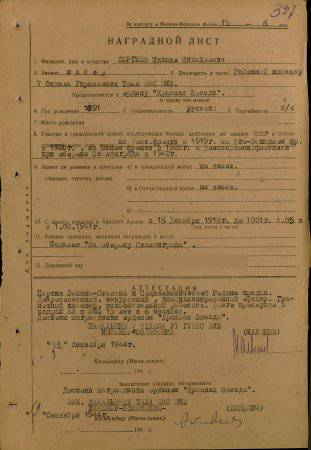
Konstantin Mikhailovich told how 19 of November 1944 of the year, on the Day of Artillery, on the anniversary of the start of the Battle of Stalingrad, was released for two weeks to Moscow. He informed his father by telegram about his imminent arrival. At the train station in Murmansk, an officer in the form of the NKVD approached him and asked him to transfer a small package to his relatives, assuring him that he would be met at the Yaroslavl station in Moscow. When the train approached the platform, Constantine saw his father hurrying to the carriage. But the first came several officers from the department of Lavrentiy Pavlovich Beria. By that time, Mikhail Mikhailovich was already a staunch realist ... He slowed down his steps, hid behind a pillar and began to observe how events would develop further. You should have seen his joy when he realized that nothing threatens his son.
Konstantin Mikhailovich said that his father was a wise and cautious man, only this allowed him to save life in conditions of monstrous repression. Sergeev perfectly understood the situation, he knew that with his biography he represented a tasty morsel for the NKVD enthusiasts. Therefore, he was never arrogant, avoided making speeches with reports and initiatives, and managed not to make enemies for himself. He preferred hunting and fishing to an active social life, he behaved with dignity, as it should be for a real naval officer, a cultured and educated person.
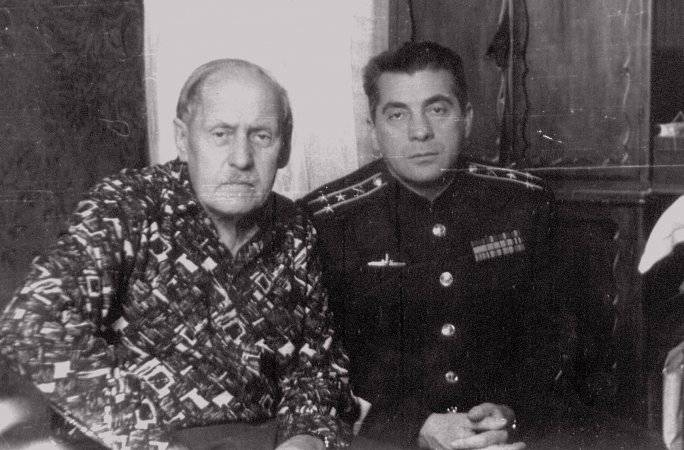
For many years he taught at the Moscow Higher Technical School. N. Bauman, took an active part in the work of the Moscow veteran organization and died in 1974, at the age of 83. At the grave of the first commander of the naval aviation of the Azov and Black Seas at the metropolitan Vagankovsky cemetery, the Black Sea pilots installed a granite boulder, specially delivered by them from the Crimea.
In the footsteps of Mikhail Mikhailovich went son and grandchildren - Andrew and Cyril. All of them after the termination of the Higher naval engineering school of F.E. Dzerzhinsky became a mechanical engineer. The life and merit of the captain 1 rank Konstantin Mikhailovich Sergeev deserve a separate story.
Information